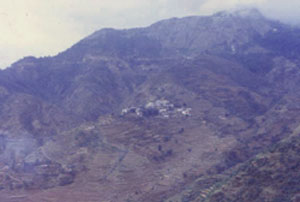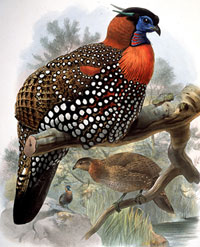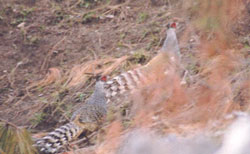Adventure
 'I believe any trip in search of wildlife can be coupled with physical activity and elements of cultural diversity to form a thrilling opportunity ' 'I believe any trip in search of wildlife can be coupled with physical activity and elements of cultural diversity to form a thrilling opportunity '
John H.Eickert
Udhagamandalam is the name given to a small town in the northern Nilgiri Hills of Tamil Nadu. Thankfully, the name has been shortened to Ooty. Ooty has been known as ‘the Queen of the Blue Mountains’ and is
the source for adventure this month. Ooty is far off the standard tourist track and is one of three hill stations the British developed, for their own unique tastes, over 160 years ago. Ooty became a place to escape the heat of the plains below. Lakes were
created and places given names suggesting central England, even the forests were cut to more resemble the homeland. Of course, this was so very long ago and now, Ooty is India. India with tea plantations and thick forest, but with less hustle and bustle than
most places. Here are unique tribal people including the Todas, Badagas, Kotas, Kurumbas, and Irulas and a seldom-visited park named Mudumalai Wildlife Sanctuary. Mudumalai joins the better-known Bandipur Wildlife Sanctuary. Ooty is the terminus of the famous
Mettupalayam to Ooty narrow gauge railway, the Blue Mountain Railway.

When I think of traveling in India, I often romanticize about the rail system. The journey, by rail, across the plains and up into the Nilgiri Hills is one of the most exciting passages. I visited there so long ago now, the memory of the visit a haze in my
mind resembling the view out across the simmering plains from Mukurti Peak. I had met a very interesting student when I visited the Taj Mahal. Through the long hot day, watching the shadows work their magic on the Taj Mahal, we struck up a plan to escape the
heat into the Nilgiri Hills. We traveled south. I was interested in experiencing the life of the sadhus and riding the trains. We arrived in Ooty and trekked through the hills living off of the good will of others. I tried chewing the betel during this epic
adventure. Time passed and we returned to Ooty. I was thin, tired, and have not touched betel since. I am not much of a sadhus, but I do remember the warm, smiling people I encountered along the way.
The train up into the Nilgiri Hills and the treks or day hikes into the forests and along the plantations is perhaps the most uniquely India adventure I can describe. Though the mountains here are not as high as with other trekking opportunities, the hills
tend to be steep and endless, not easy. There are rivers and waterfalls to cool the air. There is an elephant training school here as well. The best season to visit is April through June. Longer treks now require special permits inquire in advance. High summer
is now upon us in Montana, as the ticking heat of the day rises, I look up into the mountains here, and my mind drifts back to those Nilgiri Hills, the train, and betel. Take the time to travel and adventure, and when you do take your time.
Visit
http://www.numbum.net or call NumBum Adventurers at 406-777-2228
|
Answers To Quiz Of The Month
Last month no one has given all right answers, but roopam_dhawan@eth.net has given 9 right answers
Right Answer to
Quiz on Leopards
|
| 1.During the 1960s and 1970s, -----------------------was a major threat to the leopards in many areas. |
|
fur trade |
deforestation |
killing in retaliation of attacks on humans
|
|
| 2.During 1998-2000, -------------------------- people were attacked by leopards in Bori Budruk( Western Gahts) |
|
| 3.The reason for increased man-leopard conflicts in the Western Ghats is |
|
Forests drowned by vast new dams |
Hunting of wild deer, boar and sheep
|
Both the above
|
|
| 4.Adapted leopards find ideal habitat in
|
|
cane fields
|
flower beds |
vegetable fields
|
|
| 5.Forest Officers deal with the problem by |
|
trapping & housing the leopards in nearby zoos
|
trapping & releasing leopards
|
shooting the man-eaters
|
|
| 6.Wildlife Protection Society of India ( WPSI) has for the first time in India used sub cutaneous microchips on lepards caught in |
|
Guwahati |
Kerala |
Maharashtra
|
|
| 7.In the year -----------------Peter Pallas first described the snow leopard identifying it as a species separate from the common leopard
|
|
| 8.The snow leopard prey mostly on ungulates like |
|
chinkara & bison |
chital & sambhar |
bharal & ibex
|
|
| 9.This leopard inhabits alpine and sub alpine regions and is usually found above the tree line over 3000 meters
|
|
snow leopard |
clouded leopard |
leopard cat
|
|
| 10.Among the cat family, these are the best climbers; they can climb upside down and hang from branches with their hind feet.
|
|
Snow leopard |
Common leopard |
Clouded leopard
|
|
Please try our quiz for the current month on
Pheasants
|
Endangered
Dr. Susan Sharma
Schedule I, Part III of the Indian Wildlife (Protection) Act, 1972 lists rare and endangered birds which are totally protected throughout the country, live or dead or part thereof. They include Andaman Teal, Assam Bamboo Partridge, Bazas, Bengal Florican, Blacknecked
Crane, Blood Pheasants, , Cheer Pheasant, Eastern White Stork, , Jerdon's Courser, Great Indian Bustard, Great Pied Hornbill, Hawks, Hooded Crane, Hornbills, Houbara Bustard, Humes Bartailed Pheasant, Indian Pied Hornbill, Lammergeier, Large Falcons, Large
Whistling Teal, Monal pheasant, Mountain Quail, Narcondam Hornbill, Nicobar Megapode, Nicobar Pigeon, Osprey, Peacock-Pheasant, Peafowl or Indian Peafowl, Pinkheaded Duck, Scalter's Monal Pheasant, Siberian White Crane, Tibetan Snowcock, Tragopan-Pheasant,
Whitebellied Sea Eagle, White-eared Pheasant, White Spoonbill, and Whitewinged Wood Duck.
The Great Himalayan National Park is perhaps the most distinct stronghold of the rare Western Tragopan in India. The most spectacular of pheasants, the Western Tragopan has been reported from all the valleys of the GHNP. This
pheasant is found in high altitude fir-spruce and Deodar forests with Ringal Bamboo (Arundinaria spp.). The maximum number of sightings have been from forests of Basu, Shilt, Nada, Chordwar in Tirthan valley.
 The tragopans or horned pheasants are medium-sized pheasants in which the sexes are highly dimorphic, the males tending toward crimson on the head and sometimes elsewhere, and with extensive white to buffy dorsal spotting.
Males also have two erectile and brightly coloured fleshy horns that are erected during courtship, and a brilliantly coloured gular lappet or bib that can be expanded and exposed during display. The round black-bordered white spots or ocelli on the tragopan's
feathers make it look like the King of Birds studded with diamonds all over. . The tragopans or horned pheasants are medium-sized pheasants in which the sexes are highly dimorphic, the males tending toward crimson on the head and sometimes elsewhere, and with extensive white to buffy dorsal spotting.
Males also have two erectile and brightly coloured fleshy horns that are erected during courtship, and a brilliantly coloured gular lappet or bib that can be expanded and exposed during display. The round black-bordered white spots or ocelli on the tragopan's
feathers make it look like the King of Birds studded with diamonds all over. .
This species is usually seen singly, in pairs, or small coveys, in fairly dense montane vegetation. The white circular spotting on the greyish upperparts, especially the lower back and upper tail-coverts is distinctive, but the spotting is less regular in females
than in males. Both sexes have reddish faces, and the legs are usually pinkish. During the breeding season the male can be identified by its distinctive call, uttered most often at dusk and daybreak at intervals of about five or ten minutes. It is a far-carrying
waa note, resembling a goose calling or the bleating of a small goat.
In winter the birds are found in the thickest parts of the oak, chestnut, and morenda pine forests having a dense undergrowth of ringal bamboo. But, during the breeding season, they are to be found in the higher parts of the forest,
up to the zone of birches and white rhododendrons, and almost up to the extreme limits of the forest. Roosting by these birds is done in trees, preferentially low evergreens, where there are closely inter-woven leaves and branches, rather than in taller trees.
Great Himalayan National Park is one of only two National Parks in the world to support a population of endangered western tragopan Tragopan malanocephalus. Very limited work has been done on methods for survey and census of these
galliformes. The Parvati Hydel Project has carved out the Great Himalyan National Park destroying the very habitat of these birds. The few that are left are hunted by man for its feathers. The Western Tragopan vanishes for its colourful plumage. Legend tells
that that God created the Tragopan out of feathers shed by every bird in the universe.
Captive breeding for conservation is being attempted at Sarahan in Himachal Pradesh with little success so far.
( Picture Credit: A.O. Hume)
|
Forest and trees
Tamarind
Botanical Name: Tamarindus indica Sanskrit name: Tintrini Hindi Name: Imli
The name Tamarind is derived from the Arabic word, Tamar-Hind meaning Indian Date.
Although tamarind has been used in India from the most remote times against scurvy, it is also known for its effectiveness against mouth and throat infections. Indeed, the most famous tamarind tree
in India stands over the tomb of the legendary Indian Singer, Tansen, whose golden voice led the Great Moghul, the Emperor Akbar, to name Tansen one of the nine gems of his court. Four centuries later, India’s finest classical singers still travel to Tansen’s
tomb to pluck leaves from this tamarind tree to make into throat gargles, in the hope that their voices will become as pure as their legendary predecessor’s.
Tamarind is a large, handsome, symmetrically spreading tree. It has small compound leaves, yellowish flowers with reddish streaks and fleshy, brown fruits. The seeds are dark brown and shiny. The fleshy
fibrous pulp of the fruit is acidic.
Tamarind was an important item of diet of sailors in olden times as its acid and sugar content helped them to offset their starchy diet.
Being such a popular tree from ancient time, many stories, both mythological and tribal, is happening to associate with it.
According to a Bihar tribal story, ”the reason for Tamarind leaves to be small is because Lord Rama, Lakshmana and Sita while on their exile of fourteen years came to a forest that grew Tamarind trees.
The tamarind those days had large, well-developed leaves. Rama, his wife and brother made a hut under it. The large leaves of the tree sheltered them well. Rama said that they were supposed to suffer inconvenience during their exile but this tree was sheltering
them from rain and sun, giving them protection from the intense heat and cold which were city comforts. He ordered Lakshmana to shoot at the leaves with his bow and arrow and since then the leaves are finely divided.”
Tamarind tree got famous in Hindu mythology because of Usha, the adopted daughter of Parvati. It is in her memory that no salt is taken in the month of “Chaitra”(Chaitra is one of the months from Hindu
Almanac) and instead, food is seasoned with imli, the pulp of the tamarind fruit which is exceedingly sour.
The story goes back to Lord Ganesha getting an elephant head. “One day Lord Shiva was coming after his bath when he saw his daughter usha playing with Ganesha. He was in angry mood and finding the two
playing and ignoring him, his anger rose further and he cut off his son’s head. Parvati lamented the death of her son and insisted that he be brought back to life. To pacify her, Shiva replaced the severed head of his son by that of an elephant, and thus revived
the child. Usha had witnessed the scene and in fright, hid in a barrel of salt. When Parvati found her, she was annoyed at her for not looking after Ganesha who because of her negligence had to have an elephant head. She cursed Usha to be born on earth as
the daughter of Banasura of Tezpur in Assam. Usha protested that on earth she would die unrecognized and ask for forgiveness. But a curse once pronounced could not be revoked. Parvati relented and gave Usha a boon that in her memory that no salt would be taken
in the month of Chaitra but instead the juice of Tamarind fruit would be used to season the food, because Usha had hid in a barrel of salt to escape the wrath of Shiva.”
The pulp of the tamarind fruit, an important source of Viatmin C, is a popular ingredient in the curries, rasams, chutneys and preserves of South India. Valued as an antidote to heat stroke, tamarind
pods are often preserved in salt and are sold by weight. The whole plant has medicinal virtues. Its leaves are cooling while bark and seeds are astringent, a tonic and reduces fever. The fruit pulp is digestive, cooling and laxative.
Importance of Indigenous plants in Indian Mythology and folklore—Compiled by Ms. Priti Sawant
|
News and Views
News….
Rare and endangered!!
This month's "WildBytes" features a write up on the endangered tragopan pheasant and a heartfelt cry from Uttaranchal to save the Chir pheasant. We also feature a quiz on pheasants this month. Seeing these birds at close quarters
( you can see them in the Nainital Zoo ( Uttaranchal) and Sarahan Breeding centre ( Himachal Pradesh), redefines one's idea of beauty. Are we destroying the unparalleled beauty of nature and its creations for our own selfish purposes? We wish that the monal
and tragopan will survive for future generations to glimpse them.
Sing a song for the Chiru!
Wildlife Institute of India has coined the catchy phrase" Say No to Toosh". How about hearing it in song form from Usha Uthup in her inimitable style? Click here to hear her sing this song as well as the song she specially composed
for saving animals.
http://www.indianwildlifeclub.com/mainsite/mp/track1.mp3 and
http://www.indianwildlifeclub.com/mainsite/mp/track2.mp3
We thank Smt. Usha Uthup for making the CD available for IndianWildlifeClub members.
Slide show on tigers
The tiger contest online closes in September. So hurry and send in your entries. We are giving away three attractive prizes for the best entries. So, log in with your email id and password for IWC.com and write a script in 100
words for the slide show. Please remember to fill in your email id in the online entry form. This enables us to identify the contestants.
Advertisement for IWC.com
Those of you who are running a business or know someone running a travel business can help in procuring some advertisement revenue for IWC.com.
Opportunities for advertisement:
Your banner (or logo and 50 words text), with a web link, displayed in "WildBytes" monthly e-zine will be uploaded at the following charges
(Payable in advance)
1 month for Rs 1,000/-
6 months for Rs 5,000/-
12 months for Rs 9,000/
(Banner size 468x60 pixels)
Alternatively you can simply have your logo/weblink (120x100 pixels approx) displayed as described for half the above costs.
What's more - your advertising can start with just one day's notice. And if you need a banner designed we can do that too!
So - reach the audience you want to reach - the modern and cost-effective way.
Please send in the code/banner to be uploaded to iwc@indianwildlifeclub.com, copy to susan_sharma@hotmail.com.
A print copy of the banner/advertisement, along with draft/cheque favoring IndianWildlifeClub.com payable at New Delhi, may be mailed to IndianWildlifeClub.com, C-2490, Sushantlok I, Gurgaon 122002.
We reserve our right to refuse advertisements which are offensive/unacceptable.
And Views……………
The predicaments of conservation by Ashwini Chhatre and Vasant Saberwal
The conservation establishment in India periodically finds itself caught in a cleft stick—between the developmental onslaught on biodiversity and local resistance to conservation projects that threaten human livelihood. Conservation as a necessary agenda requires
a new vision that transcends the inherent limitations of the current practice.
....................................
The crux of the problem, therefore, is interest groups. What is the support base for biological conservation in the country? ............To some extent public opinion in the metropolis does influence conservation policy. It influences
the way the Supreme Court may make decisions that have far-reaching legal and social consequences. And to that extent, it is important that information be made available to a public so that an informed opinion can be formed. But once policy has been formulated,
the weight of various interest groups determines the ways and means by which this policy is implemented. For too long, Indian conservationists have focused their efforts on the crafting of public policy and the shaping of public opinion within urban India.
Too little effort has gone into understanding the negotiated and fiercely contested process by which such policy is implemented.
An alternative perspective that has emerged in recent years places local communities at the centre, rather than on the periphery, of the entire exercise. The crux of this argument is that the environment needs to become a part
of electoral politics within rural India. The objective, then, is to turn electoral power around, such that pressure from below works in the service of, rather than against, conservation.
Popular support for conservation can only come when local communities play a greater role in the decision-making concerning protected areas which affect them. Such support comes from a sense of control over a resource and a negotiating
process in which the community perceives itself to be an equal partner with outsiders who also stake a claim to managing the area. Conservation partnerships with local interests are not easy to forge since these imply a loosening of state control over people
and resources. Such collaborations also pose an intellectual threat to scientists accustomed to having it their way.
The Great Himalayan National Park of Himachal provides a unique opportunity to test the waters of community participation. There is mounting empirical evidence supporting the view that security of tenure is the most compelling
incentive for participatory conservation. GHNP is probably the only protected area in India, which affords us the luxury of indulging all the stakeholders without compromising on basic scientific and social principles. Where else in India would you find 1100
square kilometres of area with only 15,000 people, that too populating only its southwestern periphery?
There are even now large areas inside the park that have fallen into disuse. It is possible to devise a scale of graded protection to different areas inside the park, ranging from totally closed areas to fully open spaces near
villages. The villages are characterized by strong community institutions, which could be harnessed in a new conservation paradigm. But for that to happen, community representatives, politicians, conservationists and biologists ought to agree to negotiate
and make the necessary compromises. This could signal the end of exclusionary conservation choices forced by urban middle-class India upon its fellow citizens who rely on the forest, and the institutionalization of a more adaptive system of managing biological
heritage.
(Courtesy: http://www.himalmag.com/june2001/opinion.html)
|
Understand The Animals
By: Yasser Arafat
It is a known fact that wildlife in most places are decreasing at an alarming rate. And may be many people may say, YES! And steps should be taken to protect them but how many are there who would take the first steps…..
Let me ask : Can any individual or organization tell how many cheer pheasant are left in the wild and what steps are there to protect them? Not only cheer pheasant but other wild animals and birds of Nainital District such as
serow and koklas pheasant? I wander the jungles of UP ( Utter Pradesh) looking for birds and animals….I have been doing this from the last many years. There are some disturbing facts which I would like to bring to the notice of all.
Pheasants such as cheer and koklas are decreasing at an alarming rate.
 Three to four years ago I have seen 20 to 30 cheer pheasants. Now these places do not have a single cheer pheasant. Those places which are too far from human inhabitation have some population. But their numbers are decreasing
and steps should be taken to protect them before it is too late. If serious protection measures are not taken, then very soon cheer pheasant will disappear from the Nainital District of Uttaranchal. Three to four years ago I have seen 20 to 30 cheer pheasants. Now these places do not have a single cheer pheasant. Those places which are too far from human inhabitation have some population. But their numbers are decreasing
and steps should be taken to protect them before it is too late. If serious protection measures are not taken, then very soon cheer pheasant will disappear from the Nainital District of Uttaranchal.
Last year in the rocky area there were eleven cheer who roosted on three four small pine trees. I used to love watching them. But this year when I went to photograph them, to my horror, all four pine trees were cut for pine wood. The undergrowth was also gone
but then this grass was always cut by the surrounding villagers.
Our government should protect at least one or two such places where the cheer can live without human disturbance. I hope soon some steps will be taken to save this beautiful pheasant.
( Photograph of cheer pheasant in the wild by Yasser Arafat)
|
Zoo
 |
Toby Ninan retired from Delhi Zoo about two years back. With his varied experiences with the wild animals in the zoo, he is the right person
to direct your queries to. Hear what Ninan has to say about his life and chosen career! |
Among my duties at the Zoo as its Curator were to catch and bring back to the Zoo wild animals that were creating a nuisance for the city folk of Delhi and its surroundings.
This job, though was an interruption in my regular work, sometimes would provide for a lot of interesting interludes outside the Zoo. And always provide an opportunity for quite a bit of display of bravado that gained me a lot
of hero worship from the unsuspecting onlookers who naturally did not know anything about the capture process. A snake capture had always earned me a lot of ‘ fame’ from the impromptu audience that one could always find.
It was a fine morning and though our secretary tried his level best to get rid of a constant caller – this man was so persistent that I was told there was a Python some 8-10 feet in length making its temporary abode in a temple
and that too at a Shiva temple near the eastern banks of the river Yamuna. Usually the size of a snake which people want to be captured is very much exaggerated and a size of 8-10 feet usually ends up as a 2-3 foot.little fellow- However this was not to be
so in this case and as soon as I reached the temple I was pleasantly surprised to find a really big one all of 11 feet in length.
I was duly escorted to see the temple premises and offered some fruit and tea.- these are offerings one gets after the job is done and I was curious as to why the hospitality was given before the snake was in the bag. I soon came
to know the reason---the snake was quite calm and only lifted its head from its coils now and then as if to acknowledge the worship which devotees were offering the live goddess (it turned out to be a female). The devotees would also, from time to time, throw
five rupee , ten rupee and even twenty rupee notes on to the snake’s body. This would have added up to a tidy sum and though the pujari of the shrine wanted to get rid of this unwelcome or welcome visitor, he was certainly interested in the wonderful windfall
which visitors donated. Torn between these two emotions he (the pujari) was happy to see me come as a 'guardian angel’ who would make sure that no body was hurt and at the same time the kitty was being filled up at an accelerated rate.!
There was only one way in which he could keep both emotions satisfied --- that was to keep me around as long as possible, supervising the snake to make sure it would not attack any one and that was by plying me with tea and plenty
of snacks--- He begged me to stay on as long as possible. Though he had my sympathy, I could not stay more than half an hour as my boss would want the transport and also I had my work pending both at my desk and among the animals of the Zoo.
Finally after some 40 minutes I could not stay much longer. When the snake lifted its head as if to acknowledge more of its admires, I grabbed its neck. She was a heavy animal and with some difficulty I was able to bundle her
head, body and tail into the burlap sack that I had brought along for this job.
The snake safely in the bag and the old boy pujari picking up the last of the coins and notes strewed so generously around the ground where she sat—the driver and I moved out the heavy bag into the zoo vehicle. Soon the bag and
its contents nestled comfortably on the back seat of our old Ambassador car which seemed to tell me 'I have seen plenty of these!’
There was a cheering crowd and a not too unhappy pujari seeing us off and that was the successful end to another one of my jaunts!
|